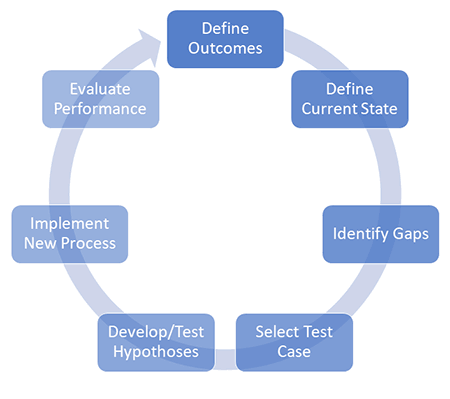Business Process Reengineering (BPR) Definition
Learn about BPR and how it's used to scale and improve business operations.

Business process reengineering promises efficiency, engagement, and productivity, but is this a realistic expectation?
Getting ahead in the business world requires organizations to survive obstacles and develop a way to turn them into opportunities. Instead of forcing things to go the way you want, sometimes you must step back and rethink your core business functions. That can mean returning to the drawing board and breaking down how everything works.
What Is Business Process Reengineering (BPR)?
You may have recently heard the term BPR in the context of improving processes and increasing business profitability, but what exactly is it? BPR stands for Business Process Reengineering. The definition of business process reengineering (BPR) is a systematic, disciplined approach to reducing organizational costs and redundant business processes involving the analysis of existing human and automated workflows.
In large businesses — and even smaller or medium-sized ones — processes can build up over time, becoming legacy snarls deeply entrenched in how things are done. BPR is a proven methodology that allows organizations to cut the Gordian Knots that may hold back genuine improvements and cost optimization.
When is Business Process Reengineering Required?
The need for business process reengineering surfaces in a variety of ways. For instance, our article "Is it Time to Overhaul Your Processes?" provides some indicators that it may be time for a BPR project.
- Customer complaints and refund requests are rising.
- Staff stress, disputes, and turnover are high.
- Chaos reigns after experienced employees depart or go out on leave.
- Profitability is falling.
- Sales leads are not being followed up quickly.
- Corporate governance has been lacking.
- You are struggling with your cash flow.
- Your inventory levels are rising.
- You can't fill customer orders quickly enough.
 What Are the Business Process Reengineering Steps?
What Are the Business Process Reengineering Steps?
1. Figure out what you want
What do you expect to see after the execution of a specific business workflow? Once you understand how you want your business outcomes to work, you can start figuring out why it isn't happening. For example, if you're looking to get deliveries to customers within a specific timeframe, look at ways to speed up getting items out of the warehouses and into a delivery truck.
2. Define the current state
Go through the steps involved in completing a work process. Look at places where logjams might occur that bring down efficiency and add to costs.
3. Identify gaps
Set up key performance indicators (KPIs) that give you an idea of how close or far you are from achieving your business goals. Look at cycle time, the production process, or how long it takes to load trucks at the warehouse.
4. Select a test case
Look for an essential process that impacts your organization's effectiveness. Then, develop a future state that helps you achieve your company's strategic objectives.
5. Develop and test your hypothesis
Develop new workflow and procedures, then communicate to the relevant stakeholders. Create test scenarios for any new or enhanced functions within your revamped process.
6. Implement the new process
Ensure you have the dependencies and resources to roll out your changes successfully.
7. Evaluate performance
Track the performance of the new process and use your KPIs to assess the impacts compared to the original business workflow.
Your goal should be creating clear strategic improvements to your work processes versus trying to go about business as usual in a shiny new package. It's about coming up with new ideas, like changing how you engage with customers at every point in the sales process.
BPR and Continuous Improvement
Continuous improvement (CI) is an ongoing effort to improve a product, service, or process. The American Society for Quality (ASQ) holds that CI efforts can include incremental improvement, where improvement occurs gradually over time, and breakthrough improvement, where the improvement happens simultaneously. CI often requires an organization first to undergo a cultural change before it can have any real chance of success.
Business process reengineering is often part of CI efforts, as teams look for ways to improve business processes as part of the overall CI scope. BPR is also closely tied to Business Process Management (BPM), and it makes sense to have a healthy understanding of both disciplines. You can read our Introduction to Business Process Management for a complete overview of BPM.
What are the Pros and Cons of Business Process Reengineering?
While most companies find that the benefits of BPR far outweigh the negatives, here are some pros and cons to consider.
Pros
- Can improve business performance and productivity.
- It can reduce costs and improve competitive advantage.
- Can improve customer service.
- It can introduce greater flexibility and responsiveness.
- It can simplify operations and processes.
Cons
- It can require a significant investment of resources.
- This can create disruption and resistance within the organization.
- It can be challenging to manage and implement.
- This can lead to increased complexity and confusion.
- It can produce unexpected negative results.
So, Is BPR the Same as BPM?
No. While BPM focuses on defining and automating existing processes, BPR completely re-imagines how businesses operate, especially regarding customer experience. BPR also has much higher stakes because today's roles and processes may be shelved entirely.
If you'd like to learn more about BPM, we have a free, open guide you can read online or download as a PDF. Visit the Guide.
Process Re-Engineering Examples
BPR Resources
- On Wikipedia
- On TechTarget
- Gartner Glossary Definition
- Excellent overview with examples on Cleverism.com
- Video on Study.com
Interested in Reengineering and Automating Your Processes?
We have a variety of resources to help you on your journey to an automated workflow.



